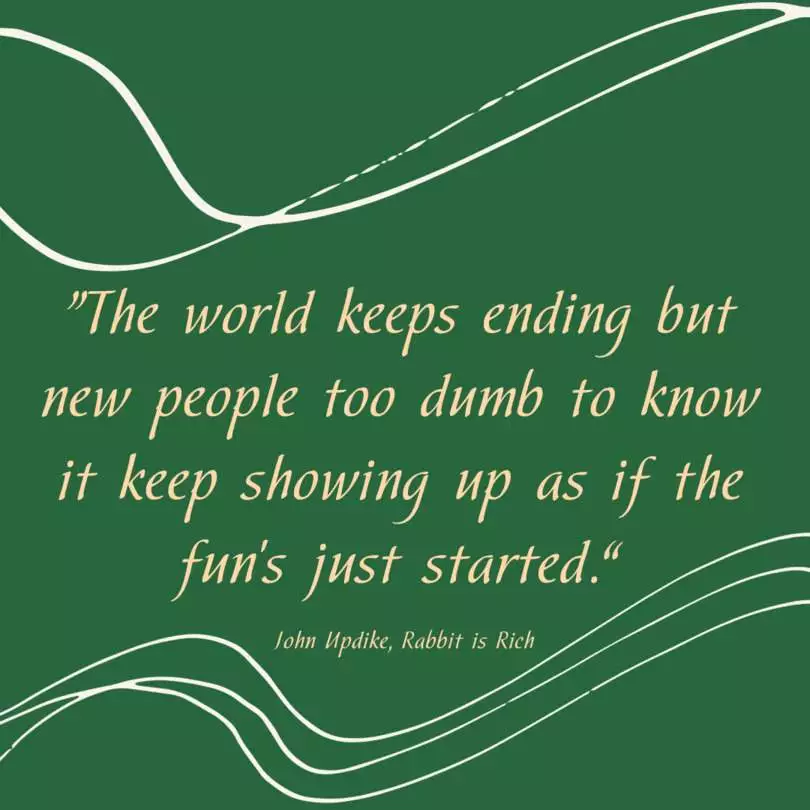A Riveting Tale of Ambition, Love, and Midlife Reflection – John Updike’s “Rabbit Is Rich”
Dive into the enthralling world of Harry “Rabbit” Angstrom in John Updike‘s compelling novel, “Rabbit Is Rich.” The third installment in the Rabbit series, this book takes readers on a journey through the complexities of midlife, ambition, and the pursuit of the American Dream. Set in the 1970s, the novel follows Rabbit as he navigates the challenges of success, wealth, and love. With its incisive character portrayals and sharp social commentary, “Rabbit Is Rich” offers a poignant reflection on the human condition and the timeless quest for fulfillment.
The Midlife Reflections of Rabbit Angstrom: Rabbit Is Rich
In “Rabbit Is Rich,” we find Rabbit Angstrom in his forties, grappling with the realities of midlife. As a successful car salesman and owner of a Toyota dealership, Rabbit is now “rich,” but the novel delves into the complexities of wealth and its impact on his life.
Through Rabbit’s introspections, we witness his deep-seated insecurities and regrets. Updike’s masterful characterization captures the essence of Rabbit’s midlife crisis, making him a relatable and multi-dimensional protagonist.

The Allure and Pitfalls of Success: Rabbit Is Rich
As Rabbit finds financial success, he becomes entangled in the allure of wealth and material comforts. Updike’s exploration of the American Dream sheds light on the temptations and pitfalls of financial prosperity.
Rabbit’s pursuit of success affects his relationships, particularly with his wife, Janice, and his son, Nelson. The novel examines the complexities of family dynamics and the strains that financial success can place on intimate connections.
Family and Love in Turmoil:
“Rabbit Is Rich” is not solely a story of Rabbit’s personal journey; it also delves into the dynamics of family and love. Janice’s dissatisfaction with her life leads to conflicts with Rabbit, adding layers of tension to their marriage.
Meanwhile, Rabbit’s relationship with his son Nelson is fraught with miscommunication and misunderstanding. Updike’s portrayal of familial bonds captures the universal struggles of parenthood and the complexities of love in the face of changing circumstances.
Social Commentary on the 1970s:
Set in the 1970s, “Rabbit Is Rich” serves as a captivating commentary on the social and political climate of the era. Updike weaves significant historical events, such as the energy crisis and the Watergate scandal, into the novel’s narrative.
Through Rabbit’s observations and interactions with others, the novel becomes a reflection on the changing landscape of American society during that tumultuous decade. Updike’s keen social commentary adds depth to the story, making it a compelling snapshot of its time.
A Mosaic of Human Experience:
“Rabbit Is Rich” is a mosaic of human experience, skillfully capturing the complexities of life. Updike’s keen observations of human behavior and emotions create a rich tapestry of characters and relationships.
The novel explores themes of aging, desire, and the search for meaning, presenting a profound meditation on the human condition. Updike’s nuanced storytelling and vivid prose make “Rabbit Is Rich” a literary triumph that resonates with readers from all walks of life.
John Updike’s Literary Craftsmanship:
Throughout “Rabbit Is Rich,” John Updike’s literary craftsmanship shines brightly. His evocative prose and insightful characterizations elevate the novel beyond a conventional narrative, creating a compelling exploration of human nature.
Updike’s ability to blend personal introspection with social commentary showcases his storytelling prowess. “Rabbit Is Rich” stands as a testament to Updike’s literary genius and his gift for capturing the essence of the human experience.

Famous Quotes from “Rabbit is Rich” by John Updike
- “Money is life’s report card.”
- This quote reflects Rabbit’s growing preoccupation with wealth and status in middle age. As he achieves financial security, he views money as a measure of success and personal worth. It encapsulates a key theme in the novel, which examines the materialism and consumerism of American society in the late 1970s.
- “People think of the future as a blank sheet of paper that men can write on; actually it is a spiral notebook from which the pages must be torn along the perforations.”
- This quote suggests a deterministic view of life, where despite the illusion of free will and endless possibilities, our paths are often predictable and influenced by past events. It reflects Rabbit’s sense of confinement within the cycles and patterns established in his earlier life.
- “He wonders if other men are as crushed by the monotony of life as he is.”
- Here, Updike delves into Rabbit’s internal struggle with ennui and dissatisfaction. Despite his economic success, Rabbit feels unfulfilled, pointing to the emptiness that can accompany the pursuit of material wealth.
- “Getting old is just a lot of things getting away from you.”
- This poignant observation speaks to the theme of aging and loss in the novel. As Rabbit ages, he confronts the realities of physical decline and the loss of opportunities and loved ones, encapsulating a universal aspect of human experience.
- “The world keeps ending but new people too dumb to know it keep showing up as if the fun’s just started.”
- This cynical take reflects Rabbit’s disillusionment with the ongoing cycles of life. He perceives the younger generation as naive, not yet aware of the inevitable disillusionments of life that he has come to understand.
Trivia Facts about “Rabbit is Rich”
- Pulitzer Prize Winner: “Rabbit is Rich” won the Pulitzer Prize for Fiction in 1982. This award highlighted the novel’s critical acclaim and solidified Updike’s reputation as one of America’s foremost writers.
- Part of a Series: The book is the third in a series of four novels centered around the character Harry “Rabbit” Angstrom. The series provides a deep, longitudinal view of Rabbit’s life and the societal changes in America from the 1950s through the 1980s.
- Setting and Time Period: The novel is set during the late 1970s, specifically capturing the period’s economic anxieties and oil crises, which serve as a backdrop to Rabbit’s own concerns about security and legacy.
- Themes of Affluence: Unlike the earlier books in the series where Rabbit struggles with his purpose and direction, in “Rabbit is Rich,” he is depicted as finally achieving a level of affluence, though this comes with its own set of existential dilemmas.
- Detailed Depiction of Middle Age: Updike uses Rabbit’s character to explore themes of middle age, including complacency, the fear of death, and the desire for sexual and emotional rejuvenation.
- Rich in Symbolism: The novel is filled with symbolism, notably the motif of the automobile. Rabbit runs a Toyota dealership, and cars in the novel symbolize status, freedom, and American consumer culture.
- Reception and Criticism: While the novel was praised for its prose style and depth of characterization, it also received criticism for its explicit content and portrayal of women, which some found problematic.
- Cultural Snapshot: “Rabbit is Rich” provides a cultural snapshot of the 1970s, with references to then-current events, technologies, and cultural shifts, including the sexual revolution and economic uncertainty.
- Use of Real-Life Brands and Products: Updike incorporates real brands and products throughout the novel, enhancing its realism and grounding the narrative in the recognizable material culture of the time.
- Exploration of American Dream: The novel continues Updike’s exploration of the American Dream, questioning its validity and attainability as Rabbit navigates the complexities of his own successes and failures.
The Rabbit Novels
The “Rabbit novels” is a series of four novels written by John Updike, following the life and journey of Harry “Rabbit” Angstrom, a complex and ordinary American everyman. The series begins with “Rabbit, Run,” where Rabbit, a former high school basketball star, struggles to find fulfillment in his marriage and the responsibilities of adulthood. In “Rabbit Redux,” Rabbit experiences the tumultuous era of the late 1960s, confronting political and social upheavals that mirror his personal life.
The third installment, “Rabbit Is Rich,” finds Rabbit in his forties, achieving financial success as a car salesman. However, newfound wealth brings its own challenges, putting a strain on his family and testing his relationships. In the final novel, “Rabbit at Rest,” Rabbit faces the twilight of his life, dealing with health issues and coming to terms with his choices and regrets.
Throughout the series, American Author John Updike presents a masterful portrayal of the American experience, capturing the essence of post-war suburban life, the changing social landscape, and the universal struggles of love, family, and identity. The “Rabbit novels” stand as a compelling exploration of the complexities of human existence, and Rabbit Angstrom remains one of literature’s most enduring and memorable characters.
Conclusion: Rabbit Is Rich
John Updike’s “Rabbit Is Rich” is a riveting and introspective novel that delves into the complexities of midlife, ambition, and love. Through the journey of Rabbit Angstrom, readers are invited to contemplate the allure and challenges of success, the intricacies of family relationships, and the changing landscape of American society.
As we accompany Rabbit on his personal odyssey, we are reminded of the universal quest for fulfillment and the timeless struggles of the human condition. “Rabbit Is Rich” remains a poignant and profound work that continues to captivate readers with its incisive character portrayals and keen social commentary.
For those seeking an immersive and thought-provoking read, “Rabbit Is Rich” is a literary gem that leaves a lasting impact, resonating with readers long after the final page.